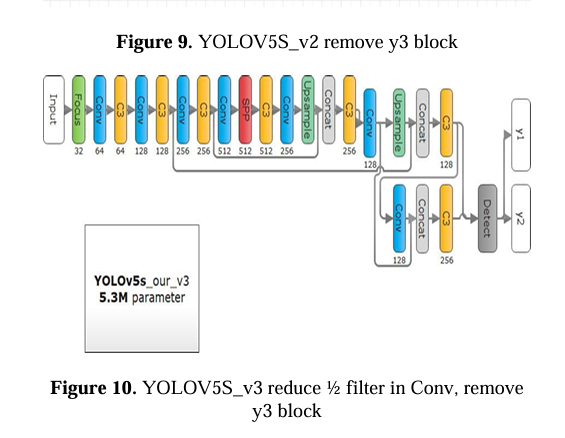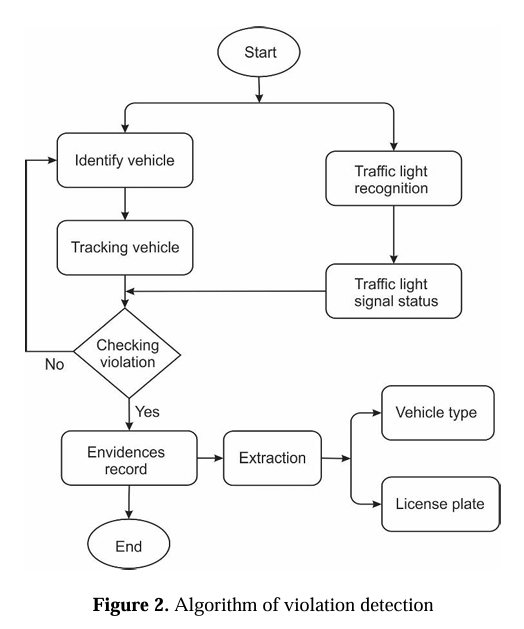Motivation
Secure Red Light Violation detection is an important application of secure machine learning protocols. Oftentimes, these systems will require the use of image segmentation and object recognition protocols. The images used for this task expose often-times sensitive data about individual users.
In the practical setting of interest, this means exposing license-plate information, associated vehicles, and location information available from the images themselves.
V2I Algorithms for RLR Detection
The authors of this paper have constructed V2I mechanisms for red light running (RLR) detection, wrong way entry (WWE), and an array of other import tasks in the context of V2X. See the citation Dokur and Katkoori (2022)
Red Light Violation Detection Algorithm
The proposed system utilizes the following logic to detect whether a car will violate a red light. A car which is approaching an intersection is connected to road-side units (RSUs) which are installed at traffic lights in an intersection.
Each light is said to be located at points B(x_{2}, y_{2}, z_{2}), C(x_{3}, y_{3}, z_{3}), D(x_{4}, y_{4}, z_{4}) and E(x_{5}, y_{5}, z_{5}) respectively.
Unlike image-based systems, this system assumes V2I communication between the traffic lights and the vehicle in question. This means that the traffic state does not need to be determined by an image classifier. Rather, we already have this information by default.
Thao et.al on Traffic Violation Detection
The paper proposed by L. Thao (2022) introduces a mechanism for detecting red light violations automatically. There paper is titled: Automatic Traffic Red-Light Violation Detection Using AI
Problem Setting
The reason AI technologies (image classification and detection) systems are better suited than standard sensor technologies is that they are able to operate more consistently, even when the number of vehicles in the setting increases dramatically.
System Design and Solution Approach
Separate the task into three parts:
- vehicle violation detection
- red signal change monitoring
- vehicle recognition
Vehicle Violation Detection
The YOLOv5s pretrained model (COCO dataset) is used for detecting violating vehicles. After detecting violation, following frames are used to try and determine the license plate (identfy vehicle). See Section 11.2.4.1 for more information on the YOLO object detection model.
Below, a picture of the overall system flow is presented:
- vehicle tracking - performed every 5 frames
- if IOU (intersection over union) of bounding box is close to one from a previous frame, then the car is assumed to be the same one from that frame.
- violation line detection
- image processing is used to determine traffic lines
- boundary lines are drawn onto frames captured by the camera later
- traffic state detection
- color filters and image processing used to detect changes in the state of the traffic light
Primary Contributions
- Implementation of modified YOLOv5s model
- used parameter changes from original model
- achieved following accuracy results:
- 82% - vehicle identification
- 90% - traffic signal status change
- 86% - violation detection
- Best Performing Architecture given below (v3 / v4)
According to a labmate, it may only be necessary to fine tune the YOLO model on 10 epochs. It may not be necessary to do any more than that.
Goma et.al on RLR Detection with SSD (Single Shot Detector)
Work by J. Goma (2020) demonstrates the ability to detect red-light-running and over-speeding with a high level of accuracy. Specifically, they achieve 100% accuracy on red light running detection and 92.1% accuracy for over-speeding violations. They accomplish these results using a CNN applied to an SSD (single deep neural network)
Methods and System Design
Dokur, O., and S. Katkoori. 2022. “Vehicle-to-Infrastructure Based Algorithms for Traffic Light Detection, Red Light Violation, and Wrong-Way Entry Applications.” IEEE International Symposium on Smart Electronic Systems.
J. Goma, R. Bautista, M. Eviota. 2020. “Detecting Red-Light Runners (RLR) and Speeding Violtion Through Video Capture.” IEEE 7th International Conference on Industrial Engineering and Applications.
L. Thao, N. Anh, D. Cuong. 2022. “Automatic Traffic Red-Light Violation Detection Using AI.” International Information and Engineering Technology Association.

